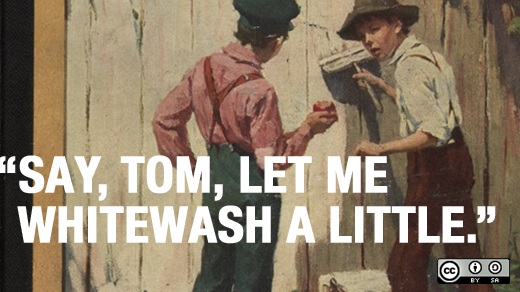A few weeks ago I wrote a post called Tom Sawyer, whitewashing fences, and building communities online, where I outlined one of the biggest mistakes I see companies make when figuring out their community strategy-- they expect a mythical "community" will paint their fence for them. But not everyone is Tom Sawyer.
If your community strategy starts with the question, "how can I make the community work for me?" you may still find success if there are a bunch of people out there willing to paint your fence for free, but you definitely are not taking advantage of all of the benefits you can get from participating in communities.
One of the most often used examples of customer/community-driven innovation (perhaps because it is simple to understand) is the My Starbucks Idea site. This is a place where customers can tell Starbucks what they want, people vote on each others' ideas, and Starbucks takes the best ideas and uses them to make their products, services, and experience better.
A recent example of a service that was launched through the site is a mini Starbucks drink card that can fit on your key chain. Sweet. It looks like they've had at least 5-10 innovations like this that have come from customer ideas, maybe more. And Starbucks is not alone-- many companies have built similar sites, as has The White House. You've seen them.
But this approach is still simple Tom Sawyer-style community-building. People just helping Starbucks paint their fence for free. So why is it working for Starbucks? Because there are people out there willing to spend their time and energy helping Starbucks make their products, services, and experience better. Not every brand can command this sort of attention and loyalty. Most can't, in fact.
My view? I do think these sort of public idea generation efforts are smart 21st century thinking when they work. But why stop there?
I get excited when I see big companies focused not only on what they take from the table, but what they bring to the table. I love to see companies that aren't afraid to be humble members of communities, rather than building the community around themselves.
 When I talk about Red Hat to folks outside the software industry, I often get asked questions like "How big is the Red Hat community?" My answer is always the same:
When I talk about Red Hat to folks outside the software industry, I often get asked questions like "How big is the Red Hat community?" My answer is always the same:
It's not our community.
Red Hat is a member of and active participant in many communities. Some of them we even lead. But when we are at our best, we don't try to own communities, we try to be valuable contributors in them (and, as Chris Brogan has pointed out, in is the key word).
How can your company be a valuable participant in a community? Some ideas to get you thinking:
What can my company bring to the table?
- Funding?
- People?
- Good ideas?
- Powerful endorsement?
- Wider attention?
I've been most proud of Red Hat when I've seen us pitch in with one of these things. Sometimes it means we acquire a company with great technology and then open source the code. Sometimes we put a lot of our contributors on a community project we think really matters. Sometimes we simply put our brand behind an effort we find meaningful or useful.
Do not confuse this with corporate philanthropy. As a publicly-traded company, Red Hat is not a contributor just for the good vibes we get when we give as much as we take. We need happy shareholders, and investors look for companies with business strategies that can deliver results.
I think being a valuable community citizen is a key part of a successful open source business strategy, and I hope Red Hat is proof that good community citizenship, when practiced consistently over a long period of time, can help deliver those business results.
This article originally appeared on Dark Matter Matters.






Comments are closed.